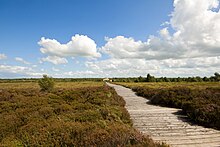Tochmarc Étaíne
Tochmarc Étaíne [ 'toxmark' eːdainʴe ] ('The wooing of Étaín') is the title of a story from the Mythological Cycle of Irish Mythology . It is handed down in Lebor Dromma Snechta ('The Book of Druim Snechta') and in Lebor na hUidre ("The Book of the Dark-Colored Cow") as well as in a large number of variations that differ in detail.
content
Étaín is the daughter of Dagda and Boann , but also in other versions the foster daughter of Bresal or the daughter of Ailill mac Máta . Oengus mac ind Óc advertises his foster father Midir to Étaín. She then becomes the second wife or lover of Midir, the son of Dagda, who lives in Síd Brí Leíth (Slieve Callory, County Longford ). Midir's first wife Fuamnach hates Étaín and pursues her with Fíth-fáth ( druid spell ). Again and again she transforms her rival, u. a. into a seagull and a fly, until it finally becomes an ethereal being that is carried away by the wind. She is swallowed by the wife of the warrior Étar and is now reborn after 1012 ( numerical mysticism ) years. As Étar's daughter, she eventually marries the King of Ulster , Eochaid Airem . In the intricate story with several versions, Eochaid's brother Ailill Anguba falls in love with her, then Midir woos her again, wins her from Eochaid in the fidchell game and flies away with her as a pair of swans. With Étain's daughter Ésa, who mistakenly thinks Eochaid is Étain himself and gets pregnant, he sires Mes Buachalla , who later becomes the mother of the famous King Conaire Mór in her marriage to Etarscél .
In another version, Midir's foster son Oengus takes Étain in as an air creature and builds her a glass house where she can relax with the scent of flowers. But Fuamnach transforms her again and so she flies over Ireland for seven years. Since Oengus sees through her magic, he beheads her together with her foster father Bresal . The further action is then similar to the version told above.
The harpist Abhcan is also said to have been killed by Oengus in the course of the plot.
Short metric line
In this narrative there are also some passages in verse form, for example a working chant by the Elven Midirs in the typical short-line song form while they have to build a dam through a swamp:
|
core i láim, |
Hand |
The background to this insertion is that Midir has a number of tasks to do, including planting a forest and building a road through the Móin Lámraige wetland ( County Longford ) within a year. With the help of his elves, he succeeds in finding the solution. This structure is said to be the Iron Age Corlea Trackway , also known as Danes Road , which still exists today .
See also
literature
- Helmut Birkhan : Celts. Attempt at a complete representation of their culture. Publishing house of the Austrian Academy of Sciences, Vienna 1997, ISBN 3-7001-2609-3 .
- Ingeborg Clarus : Celtic Myths. Man and his otherworld. Walter Verlag 1991, ppb edition Patmos Verlag, Düsseldorf 2000, 2nd edition, ISBN 3-491-69109-5 .
- Bernhard Maier : Lexicon of Celtic Religion and Culture (= Kröner's pocket edition . Volume 466). Kröner, Stuttgart 1994, ISBN 3-520-46601-5 .
- Wolfgang Meid : The Celts (= Reclams Universal Library . 17053). Reclam, Stuttgart 2007, ISBN 978-3-15-017053-3 .
- Ernst Windisch: Tochmarc Étáine: 'The outdoors around Etain'. In: Irish Texts with Translations and Dictionary 1 (1891). Egerton, pp. 113-133.
- Wim Tigges (Ed.): Tochmarc Étaíne: An Old Irish Narrative. Leiden 2015, ISBN 978-90-812010-0-1 .
